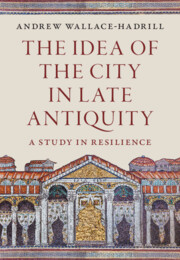Book contents
- The Idea of the City in Late Antiquity
- Praise for The Idea of the City in Late Antiquity
- The Idea of the City in Late Antiquity
- Copyright page
- Dedication
- Contents
- Figures
- Preface
- 1 The End of the Ancient City?
- 2 In Praise of the City
- 3 The City in Question
- 4 The City Revived?
- 5 The City Embattled
- 6 The City and Its Records
- 7 The City of Bishops
- 8 The Grammar of the City
- 9 The Fabric of the City
- 10 Decline and Resilience
- Bibliography
- Index
4 - The City Revived?
Cassiodorus and Ostrogothic Italy
Published online by Cambridge University Press: 30 January 2025
- The Idea of the City in Late Antiquity
- Praise for The Idea of the City in Late Antiquity
- The Idea of the City in Late Antiquity
- Copyright page
- Dedication
- Contents
- Figures
- Preface
- 1 The End of the Ancient City?
- 2 In Praise of the City
- 3 The City in Question
- 4 The City Revived?
- 5 The City Embattled
- 6 The City and Its Records
- 7 The City of Bishops
- 8 The Grammar of the City
- 9 The Fabric of the City
- 10 Decline and Resilience
- Bibliography
- Index
Summary
Through the lens of the Variae, official letters written by Cassiodorus on behalf of the Ostrogothic ruler, Theoderic, and his successors, Chapter 4 examines the concerted attempts of a ‘barbarian’ regime which took the place of Roman emperors to preserve the traditions of Roman imperial rule and support the fabric and traditions of city life. Rather than either a sham or futile nostalgia, the letters are read as an exercise in bridge-building between Roman traditions and new political realities. The emphasis placed on cities is embodied in the ideal of civilitas, based on the rule of law, city life, and a mutual respect between Roman and Goth. While betraying both the strains of urban life and the decay of much urban fabric, Cassiodorus offers a vision of the ‘modern’ based on respect for and imitation of antiquity.
- Type
- Chapter
- Information
- The Idea of the City in Late AntiquityA Study in Resilience, pp. 115 - 157Publisher: Cambridge University PressPrint publication year: 2025

